Students who are in search of 11th Bio Zoology exam can download this Tamilnadu State Board Solutions for 11th Bio Zoology Chapter 4 Organ and Organ Systems in Animals from here for free of cost. These cover all Chapter 4 Organ and Organ Systems in Animals Questions and Answers, PDF, Notes, Summary. Download the Samacheer Kalvi 11th Biology Book Solutions Questions and Answers by accessing the links provided here and ace up your preparation.
Tamilnadu Samacheer Kalvi 11th Bio Zoology Solutions Chapter 4 Organ and Organ Systems in Animals
Kickstart your preparation by using this Tamilnadu State Board Solutions for 11th Bio Zoology Chapter 4 Organ and Organ Systems in Animals Questions and Answers get the max score in the exams. You can cover all the topics of Chapter 4 Organ and Organ Systems in Animals Questions and Answers easily after studying the Tamilnadu State Board 11th Bio Zoology Textbook solutions pdf.
Samacheer Kalvi 11th Bio Zoology Organ and Organ Systems in Animals Text Book Back Questions and Answers
Question 1.
The clitellum is a distinct part in the body of earthworm Lampito mauritii, it is found in …………….
(a) Segments 13 – 14
(b) Segments 14 – 17
(c) Segments 12 – 13
(d) Segments 14 – 16
Answer:
(b) Segments 14 -17
Question 2.
Sexually, earthworms are ……………..
(a) Sexes are separate
(b) Hermaphroditic but not self-fertilizing
(c) Hermaphroditic and self-fertilizing
(d) Parthenogenic
Answer:
(b) Hermaphroditic but not self-fertilizing
Question 3.
To sustain themselves, earthworms must guide their way through the soil using their powerful muscles. They gather nutrients by ingesting organic matter and soil, absorbing what they need into their bodies. Say whether the statement is true or false: The two ends of the earthworm can equally ingest soil.
(a) True
(b) False
Answer:
(b) False
Question 4.
The head region of Cockroach pairs of and shaped eyes occur.
(a) One pair, sessile compound and kidney shaped
(b) Two pairs, stalked compound and round shaped
(c) Many pairs, sessile simple and kidney shaped
(d) Many pairs, stalked compound and kidney shaped
Answer:
(a) One pair, sessile compound and kidney shaped
Question 5.
The location and numbers of malpighian tubules in Periplaneta ……………
(a) At the junction of midgut and hindgut, about 150.
(b) At the junction of foregut and midgut, about 150.
(c) Surrounding gizzard, eight.
(d) At the junction of colon and rectum, eight.
Answer:
(a) At the junction of midgut and hindgut, about 150.
Question 6.
The type of vision in Cockroach is ………………
(a) Three dimensional
(b) Two dimensional
(c) Mosaic
(d) Cockroach do not have vision
Answer:
(c) Mosaic
Question 7.
How many abdominal segments are present in male and female cockroaches?
(a) 10, 10
(b) 9, 10
(c) 8, 10
(d) 9, 9
Answer:
(a) 10,10
Question 8.
Which of the following have an open circulatory system?
(a) Frog
(b) Earthworm
(c) Pigeon
(d) Cockroach
Answer:
(d) Cockroach
Question 9.
Buccopharyngeal respiration in frog …………….
(a) is increased when nostrils are closed
(b) stops when there is pulmonary respiration
(c) is increased when it is catching fly
(d) stops when mouth is opened.
Answer:
(b) Stops when there is pulmonary respiration
Question 10.
Kidney of frog is ………………
(a) Archinephros
(b) Pronephros
(c) Mesonephros
(d) Metanephros
Answer:
(c) Mesanephros
Question 11.
Presence of gills in the tadpole of frog indicates that ………….
(a) fishes were amphibious in the past
(b) fishes evolved from frog-like ancestors
(c) frogs will have gills in future
(d) frogs evolved from gilled ancestor
Answer:
(d) frogs evolved from gilled ancestor
Question 12.
Choose the wrong statement among the following …………….
(a) In earthworm, a pair of male genital pore is present.
(b) Setae help in locomotion of earthworms.
(c) Muscular layer in the body wall of earthworm is made up of circular muscles and longitudinal muscles.
(d) Typhlosole is part of the intestine of earthworm.
Answer:
(a) In earthworm, a pair of male genital pore is present.
Question 13.
Which of the following are the sense organs of Cockroach?
(a) Antennae, compound eyes, maxillary palps, anal cerci
(b) Antennae, compound eye, maxillary palps and tegmina
(c) Antennae, ommatidia, maxillary palps, stemumv and anal style
(d) Antennae, eyes, maxillary palps, tarsus of walking legs and coxa
Answer:
(c) Antennae, ommatidia, maxillary palps, sternumv and anal style
Question n 14.
What characteristics are used to identify the earthworms?
Answer:
In gardens, earthworms can be traced by their fecal deposits known as worm castings on the soil surface. The earthworms can be identified using the following characteristics:
- Long and cylindrical narrow body.
- Bilateral symmetry
- It is light brown in colour with purple tinge at the anterior end.
- The division of body into many segments or metameres.
- The dorsal surface of the body is marked by a dark mid dorsal line.
- In mature worms, segments 14-17 may be found swollen with a glandular thickening of the skin called the clitellum.
Question 15.
What are earthworm casts?
Answer:
The undigested particles of food along with earth passed out through the anus of the earthworm are called worm casting.
Question 16.
How do earthworms breathe?
Answer:
In earthworms, respiration takes place through the body wall by the moist skin diffusion, oxygen diffuses through the skin into the blood while carbon dioxide from the blood diffuses out.
Question 17.
Why do you call cockroach a pest?
Answer:
Cockroaches destroy food and contaminates it with their offensive odour. They are carriers of a number of bacterial diseases. The cockroach allergen can cause asthma to sensitive people.
Question 18.
Comment on the functions of alary muscles?
Answer:
Alary muscles are the triangular muscles that are responsible for blood circulation in the cockroach. Each segment has one pair and a pumped anteriorly to sinuses again.
Question 19.
Name the visual units of the compound eyes of cockroach.
Answer:
Ommatidia
Question 20.
How does the male frog attracts the female for mating?
Answer:
Male frog has a pair of vocal sacs and a nuptial pad on the ventral side of the first digit of each forelimb. Vocal sacs assist in amplifying the croaking sound of frog. It makes a characteristic sound and attracts the female.
Question 21.
Write the types of respiration seen in frog.
Answer:
Frog respires on land and in the water by two different methods. In water, skin acts as aquatic respiratory organ (cutaneous respiration). Dissolved oxygen in the water gets exchanged through the skin by diffusion. On land, the buccal cavity, skin and lungs act as the respiratory organs. In buccal respiration on land, the mouth remains permanently closed while the nostrils remain open.
The floor of the buccal cavity is alternately raised and lowered, so air is drawn into and expelled out of the buccal cavity repeatedly through the open nostrils. Respiration by lungs is called pulmonary respiration. The lungs are a pair of elongated, pink coloured sac-like structures present in the upper part of the trunk region (thorax). Air enters through the nostrils into the buccal cavity and then to the lungs. During aestivation and hibernation gaseous exchange takes place through skin.
Question 22.
Differentiate between peristomium and prostoinium in earthworm.
Answer:
Peristomium:
The first segment of the body of earthworm is called peristomium.
Prostomium:
A small flap overhanging the mouth is called prostomium or upper lip.
Question 23.
Give the location of clitellum and spermathecal openings in Lampito mauritii.
Answer:
In mature earthworms, 14 – 17th segments are swollen with a glandular thickening of the skin called the clitellum. Permathecal openings are three pairs of small ventrolateral apertures lying intersegmentally between the grooves of the segment 6 / 7, 7 / 8 and 8 / 9.
Question 24.
Differentiate between tergum and a sternum
Answer:
Tergum:
Tergum is the covering each segment of cockroach on the dorsal side.
Sternum:
The sternum is the covering of each segment of cockroach on the ventral side.
Question 25.
Head of cockroach is called hypognathous. Why?
Answer:
The mouth parts of cockroach are directed downwards. The head is small, triangular lies at right angle to the longitudinal body axis. Hence it is called hypognathous.
Question 26.
What are the components of blood in frog?
Answer:
The blood consists of plasma [60%] and blood cells [40%], red blood cells, white blood cells, and platelets. RBCs are loaded with red pigment, nucleated and oval in shape. Leucocytes are nucleated, and circular in shape.
Question 27.
Draw a neat labeled diagram of the digestive system of frog.
Answer:
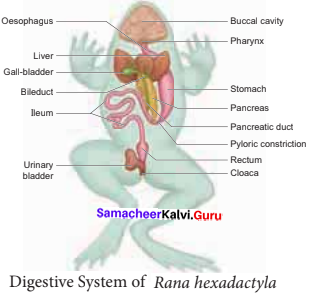
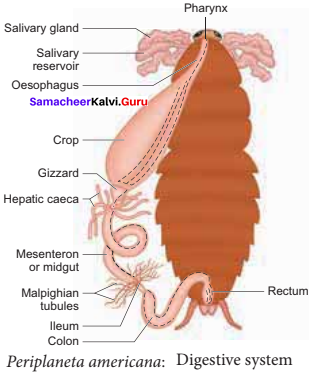
Question 28.
Explain the reproductive system of frog.
Answer:
The male frog has a pair of testes which are attached to the kidney and the dorsal body wall by folds of peritonium called mesorchium. Vasa efferentia arise from each testis. They enter the kidneys on both side and open into the bladder canal. Finally, it communicates with the urinogenital duct that comes out of kidneys and opens into the cloaca (Fig. 1).
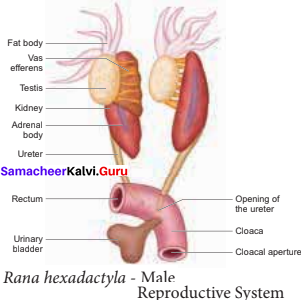
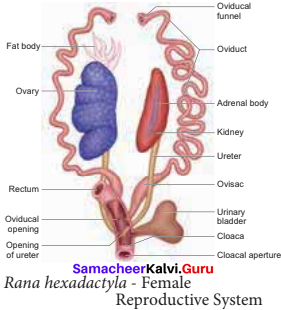
Female reproductive system (Fig. 2) consists of paired ovaries, attached to the kidneys, and dorsal body wall by folds of peritoneum called mesovarium. There is a pair of coiled oviducts lying on the sides of the kidney. Each oviduct opens into the body-cavity at the anterior end by a funnel like opening called ostia. Unlike the male frog, the female frog has separate genital ducts distinct from ureters. Posteriorly the oviducts dilated to form ovisacs before they open into cloaca. Ovisacs store the eggs temporarily before they are sent out through the cloaca.
In-Text Questions Solved
Question 1.
How do the earthworms sense activity in their habitat without eyes, ears or a nose?
Answer:
The earthworm’s receptors are stimulated by a group of slender columnar cells connected with nerves. The Photoreceptors (sense of light) are found on the dorsal surface of the body. Gustatory (sense of taste) and olfactory receptors (sense of smell) are found in the buccal cavity. Tactile receptors (sense of touch), chemoreceptors (detect chemical changes) and thermoreceptors (changes in temperature) are present in the prostomium and the body wall.
Question 2.
Respiratory system of cockroach is formed of spiracles and tracheal interconnections. Why is it said to be more efficient than that of earthworm? Why inspiration of cockroach is said to be a passive process while it is an active process in man?
Answer:
The respiratory system of cockroach is well developed compared with other terrestrial insects. Branched tubes known as trachea open through 10 pairs of small holes called spiracles or stigmata
Question 3.
Arthropod eyes are called compound eyes because they are made up of repeating units, the ommatidia, each of which functions as a separate visual receptor. What is the difference between compound eyes and simple eyes? Why is mosaic vision with less resolution seen in cockroaches?
Answer:
f an eye is made of many eyes, it is a compound eye. It has many visual receptors unlike a simple eye which has only one visual receptor. The photoreceptors of the cockroach consists of a pair of compound eyes at the dorsal surface of the head. Each eye is formed of about 2000 simple eyes called the ommatidia (singular: ommatidium), through which the cockroach can receive several images of an object. This kind of vision is known as mosaic vision with more sensitivity but less resolution.
Question 4.
Why three chambered heart of frog is not as efficient has the four chambered heart of birds and mammals?
Answer:
A 4-chambered heart can pump blood more powerfully and efficiently. This helps in better oxygenation of the blood, better circulation and better purification of the blood.
Entrance Examination Questions Solved
Question 1.
The body cells in cockroach discharge their nitrogenous waste in the haemolymph mainly in the form of ……….. (NEET 2015)
(a) Calcium carbonate
(b) Ammonia
(c) Potassium urate
(d) Urea
Answer:
(c) Potassium urate
Question 2.
Frog’s heart when taken out of the body continues to beat for sometime. Select the best option from the following statements. (NEET 2017)
(a) Frog is a poikilotherm.
(b) Frog does not have any coronary circulation.
(c) Heart is “myogenic” in nature.
(d) Heart is autoexcitable Options
Answer:
(d) Heart is autoexcitable Options
Samacheer Kalvi 11th Bio Zoology Organ and Organ Systems in Animals Additional Questions & Answers
I. Multiple Choice Questions
Choose the correct answer
Question 1.
Which of the following is found in upper layers of the soil?
(a) Perionyx exavatus
(b) Octochaetona thurstoni
(c) Lampito mauritii
(d) Eudrilus eugeniae
Answer:
(c) Lampito mauritii
Question 2.
The body setae of earthworms are concerned with
(a) sensory function
(b) protection
(c) excretion
(d) locomotion
Answer:
(d) locomotion
Question 3.
The female genital aperture lies on the ventral side in the segment.
(a) 18th
(b) 10th
(c) 14th
(d) 8th
Answer:
(c) 14th
Question 4.
The pair of male genital apertures are situated later ventrally in the segment.
(a) 18th
(b) 10th
(c) 14th
(d) 9th
Answer:
(a) 18th
Question 5.
In earthworm, what is present in the 6th segment?
(a) oesophagus
(b) intestine
(c) gizzard
(d) anus
Answer:
(c) gizzard
Question 6.
Which of the following is not found in the prostomium?
(a) Tactile receptors
(b) chemoreceptors
(c) Thermoreceptors
(d) Olfactory receptors
Answer:
(d) Olfactory receptors
Question 7.
In protandrous condition, what is correct?
(a) ova mature earlier than sperms
(b) sperms mature earlier than ova
(c) both sperms and ova mature at the same time
(d) both sperms and ova do not mature at all
Answer:
(b) sperms mature earlier than ova –
Question 8.
The mouth parts of cockroach are of type.
(a) eating and chewing
(b) chewing and sicking
(c) sucking and chewing
(d) biting and chewing
Answer:
(d) biting and chewing
Question 9.
Which of the following is right?
(a) Anal styles are present only in male cockroach.
(b) Anal styles are present in both male and female cockroaches
(c) Anal cerei are present in male cockroach only
(d) Anal cerei are present in female cockroach only
Answer:
(a) Anal styles are present only in male cockroach.
Question 10.
Which is responsible for circulation of blood in cockroach?
(a) spiracular muscles
(b) alary muscles
(c) haemocytes
(d) ostia
Answer:
(b) alary muscles
Question 11.
Cockroach excretes as the nitrogenous waste from the body.
(a) urea
(b) ammonia
(c) uric acid
(d) creatinine
Answer:
(c) uric acid
Question 12.
In cockroach, maiphigian tubules are concerned with
(a) digestion
(b) respiration
(c) excretion
(d) secretion of fluids
Answer:
(c) excretion
Question 13.
The secretion of collaterial glands in cockroach is to produce
(a) ova
(b) sperms
(c) pigments
(d) oothoea
Answer:
(d) oothoea
Question 14.
Which of the following is not a feature of frog?
(a) presence of webbed deet
(b) absence of teeth
(c) smooth and moist skin
(d) slender body
Answer:
(b) absence of teeth
Question 15.
When the frog is ¡n water respiration occurs.
(a) pulmonary
(b) gill
(c) buccal
(d) cutaneous
Answer:
(d) cutaneous
Question 16.
In frog, aortic arch divides into three aortic arches namely …………….
(a) carotid, systemic and sinus venosus
(b) carotid, systemic and pulmo cutaneous
(c) carotid, dorsal aorta and pulmo cutaneous
(d) carotic, truneous arteriosus and pulmo cutaneous
Answer:
(b) carotid, systemic and pulmo cutaneous
Question 17.
Frogs excrete and hence they are called ……………
(a) urea, urecotelic
(b) uric acid. urecotelic
(c) ammonia, ammonotalic
(d) urea, urotelic
Answer:
(c) ammonia, ammonotalic
Question 18.
Which of the following change happens during metamorphosis of tadpole?
(a) gills disappear and lungs develop
(b) lungs disappear and gills develop
(c) gills remains as such
(d) lungs disappear
Answer:
(a) gills disappear and lungs develop
II. Fill In the blanks
Question 1.
………… are the earthworms found in deeper layers of the soil.
Answer:
Endogeics
Question 2.
The segments of the earthworm are ………..
Answer:
metameres
Question 3.
The first segment of earthworm is called …………..
Answer:
prostomium
Question 4.
The last segment of the earthworm is called ……………
Answer:
pygidium
Question 5.
The swollen segments 14 to 17 in mature earthworm is called the …………..
Answer:
clitellum
Question 6.
The body setac are absent in the , last segments and allatum ……………
Answer:
first
Question 7.
The are present from the O segment onwards in the earthworm …………..
Answer:
dorsal
Question 8.
Nephrogenous eliminate wastes …………….
Answer:
metabolic/nitrogenous
Question 9.
found in the coelomic fluid of earthworm plays an important role in regeneration, immunity and wound healing.
Answer:
Coelomocytes
Question 10.
The dorsal wall of the intestine of earthworm is tblded into the cavity as the …………..
Answer:
typhiosole
Question 11.
In earthworm, the vessel has no valves and non-contractile …………….
Answer:
Ventral
Question 12.
In earthworms excretion is effected by …………….
Answer:
nephridia
Question 13
nephridia are present in the 5th – 9th segments.
Answer:
Pharyngeal of tufted
Question 14.
Special cells on the coelomic wall of the intestine called are excretory in function in earthworms.
Answer:
chioragogen cells
Question 15.
In earthworms, the male genital aperture contains two pairs of for copulation.
Answer:
penial setae
Question 16.
The secretion of the prostate gland serves to cement the spermatozoa into bundles known as
Answer:
spermatophores
Question 17.
are present in the 7th, 8th and 9th segment of earthworm.
Answer:
Spermatheca
Question 18.
The process of producing compost using earthworm is called ……………
Answer:
vermi composting
Question 19.
The first pair of wings of cockroach is called ………..
Answer:
alytra of fegmina
Question 20.
In both male and female cockroach, genital apertures are surrounded by scierites called …………….
Answer:
gonapophysis
Question 21.
helps in grinding of food particles in cockroach.
Answer:
Gizzard
Question 22.
In between the foregut and midgut of cockroach are present.
Answer:
Aepatic caecae
Question 23.
In between the midgut and the hindgut of cockroach are present which help in …………….
Answer:
maiphigian tubules excretion
Question 24.
The respiratory organs of cockroach are ……………..
Answer:
trachea
Question 25.
The trachea of cockroach open through 10 pairs of small holes called ……………
Answer:
spiracles/stigmata
Question 26.
The opening and closing of spiracles are regulated by ……………..
Answer:
sphincter spiracular muscles
Question 27.
The blood of cockroach is called as ……………
Answer:
Haemolymph.
Question 28.
The blood from the sinuses enters the heart of cockroach through the …………..
Answer:
ostia
Question 29.
in cockroach, there is a accessory at the base of each antenna which also pumps blood.
Answer:
pulsatile vesicle
Question 30.
The receptors are located in the antenna, maxillary paips and cerci.
Answer:
thigmo
Question 31.
are found on the first four tarsal segments on the legs of cockroach.
Answer:
Thermoreceptors
Question 32.
The receptor chordotonal is found on the which respond lo air or earth borne vibrations.
Answer:
Anal cerci
Question 33.
The eye of cockroach is made up of simple’eyes called the ……………..
Answer:
ommatidia
Question 34.
The collaterial glands present behind the ovaries of female reproductive system cockroach produce ………….
Answer:
ootheca
Question 35.
The young cockroach are called …………….
Answer:
nymphs
Question 36.
The temperature of the frog varies with the varying environmental temperature and hence it is called …………..
Answer:
poikulothermic
III. Answer the following Questions
Question 1.
Classify earthworms based on their ecological strategies.
Answer:
- Earthworms are classified as epigeics, anecics and endogeics based on their ecological strategies.
- Epigeics are the surface dwellers e.g., Perionyx excavaus and Eudrilus eugeniae.
- Anecics are found in the upper layers of the soil e.g., Lampiro mauritii, Lumbricus terrestris.
- Endogeics are found in deeper layers of the soil e.g., Octochaetona thursoni.
Question 2.
Explain the morphology of earthworm, Lampito mauritii.
Answer:
- Lampilo mauritii has a long and cylindrical narrow body which is laterally symmetrical.
- it is light brown in colour with purplish length at the anterior end.
- The body is divided into 165 – 190 segments.
- The dorsal surface of the body is marked by a dark mid dorsal line along the longitudinal axis of the body.
- The ventral surface has genital opening.
- The mouth is found in the centre of the first segment called peristomium. Overhanging
- the mouth is a small flag called upper lip or prostomium.
- The last segment called pygidiurn has the anus.
- The segments 14-17 are swollen with a glandular thickening of the skin called the clitellum.
- The body of earthworm is divided into pre clitellar region (1 – 13), clitellar region (14 – 17) and post clitellar region (after 17).
- Chitinous body selae are present in all segments except the first, last and clitellar segments. They are locomoting in function.
- The dorsal pores are present from the 10th segment onwards. The coelomic fluid
- communicates to the exterior through these pores and keeps the body surface moist and free from harmful microorganism.
- Between the segment 6/7, 7/8 and 8/9, supernatural openings are present.
- The female genital aperture lies on the ventral side in the 14th segment and a pair of male genital apertures are situated determinately in the 1 8th segment.
- Nephridiopores are numerous and found throughout the body except a free anterior segments.
Question 3.
Explain the internal structure of the earthworm.
Answer:
The body wall of the earthworm is very moist, thin, soft, skinny, elastic and consists of the cuticle, epidermis, muscles and coelomic epithelium. The epidermis consists of supporting cells, gland cells, basal cells and sensory cells.
Question 4.
Write a note on coelom of earthworm.
Answer;
A spacious body cavity called the coelom is seen between the alimentary canal and the body wall. The coelom contains the coelomic fluid and serves as a hydrostatic skeleton, in which the coelomocytes are known to play a major role in regeneration. immunity and wound healing. The coelomic fluid of the earthworm is milky and alkaline, which consists of granulocytes or cicocytes. amoebocytes, mucocytes and leucocytes.
Question 5.
Explain the digestive system of earthworm.
Answer:
The digestive system of the earthworm consists of the alimentary canal and the digestive glands. The alimentary canal runs as a straight tube throughout the length of the body from the mouth to anus. The mouth opens into the buccal cavity which occupies the 1 and 2 segments.
The buccal cavity leads into a thick muscular pharynx,which occupies the 3th and 4th segments and is surrounded by the pharyngeal glands. A small narrow tube, oesophagus lies in the 5th segment and continues into a muscular gizzard in the 6th segment. The gizzard helps in the grinding of soit particles and decaying leaves.
Intestine starts from the 7th segment and continues till the last segment. The dorsal wall of the intestine is folded into the cavity as the typhlosole. This fold contains blood vessels and increases the absorptive area of the intestine. The inner epithehum consists of columnar cells and glandular cells. The alimentary canal opens to the exterior through the anus. The ingested organic rich soil passes through the digestive tract where digestive enzymes breakdown complex food into smaller absorbable units.
The simpler molecules are absorbed through the intestinal membrane and are utilized. The undigested particles along with earth are passed out through the anus, as worm castings or vermicasts. The pharyngeal or salivary gland cells and the glandular cells of the intestine are supposed to be the digestive glands which secrete digestive enzymes for digestion of food.
Question 6.
What is typhiosole?
Answer:
- The dorsal wall of the intestine of earthworm is folded into the cavity as the typhiosole.
- This fold contains blood vessels and increases the absorptive area of the intestine.
Question 7.
Explain the nervous system of earthworm.
Answer:
The bibbed mass of nervous tissue called supra-pharyngeal ganglia lies on the dorsal wall of the pharynx in the 3 segment. It is referred as the brain. In the 4th segment, the sub-pharyngeal ganglia is found. The brain and the sub-pharyngeal are connected by a pair of circum-pharyngeal connectives. The double ventral nerve cord runs backward from the sub-pharyngeal ganglion. The brain and other nerves in the ring integrates sensory inputs and command muscular responses of the body.
Question 8.
Explain the receptors in earthworm.
Answer:
The receptors are simulated by a group of slender columnar cells connected with nerves. The photoreceptor are found on the dorsal surface of the body. Gustatory and olfactory receptors are found in the buccal cavity. Tactile receptors, chernoreceptors and thermoreceptors are present in the prostomium and the body wall.
Question 9.
Explain the excretory system of the earthworm
Answer:
Excretion is the process of elimination of metabolic waste products from the body. In earthworm, excretion is effected by segmentally arranged, minute coiled, paired tubules called nephridia.
There are three types of nephridia:
1. pharyngeal or tufted nephridia – present as paired tufts in the 5th segments.
2. Microncphridia or Integurnentary nephridia attached to the lining of the body wall from the 14th segment to the last which open on the body surface.
3. Megancphridia or septal nephridia – present as pair on both sides of intersegmental septa of the 1 9th segment to the last and open into intestine (Figure). The mcganephridium has an internal funnel like opening called the nephrostome. which is fully ciliated. The nephrostorne is in the preceding segment and the rest of the tube is in the succeeding segment. This tube consists of three distinct divisions, the ciliated, the glandular and the muscular region.
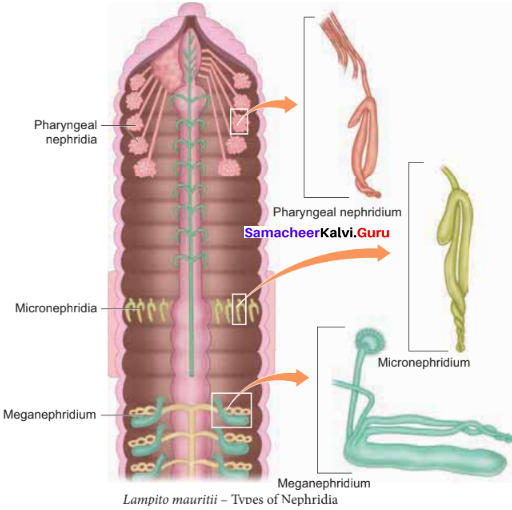
The waste material collected through the ciliated funnel is pushed into the muscular part of nephridium by the ciliated region. The glandular part extracts the waste from the blood and finally the wastes exit out through the nephridiopore. Bcsides nephridia. special cells on the coelomic wall of the intestine, called chloragogen cells arc present. They extract the nitrogenous waste from the blood of the intestinal wall. into the body cavity to he sent out through the ncphridia.
Question 10.
Explain the male reproductive system of the earthworm.
Answer:
In the male reproductive system, two pairs of testes are present in the 10th and 11th segments. The testes give rise to the germ cells or spermatogonia, which develops into spermatozoa in the two pairs of seminal vesicles. Two pairs of seminal ftrnnels called ciliary rosettes are situated in the same segments as the testes. The ciliated funnels of the same side are connected to a long tube called vas dcfcrcns.
The vasa deferentia run upto the 18th segment where they open to the exterior through the male genital aperture. The male genital aperture contains Iwo pairs of penial setae for copulation. A pair of prostate glands lies in the 18 – 9th segments. The secretion of the prostate gland serves to cement the spermatozoa into bundles known as spermatophores.
Question 11.
Explain the female reproductive system of earthworm.
Answer:
The female reproductive system consists of a pair of ovaries lying in the 3’ segment. Each ovary has finger like projections which contain ova in linear series. Ovarian funnels are present beneath the ovaries which continue into the oviducts.
They join together and open on the ventral side as a single median female genital pore in the 14th segment. Spermathecae or seminal receptacles are three pairs lying in segments 7th, 8th and 9th opening to the exterior on the ventral side between 6th & 7th 7th & 8th and 8th & 9th segments. They receive spermatozoa from the partner and store during copulation.
Question 12.
In earthworm, self fertilization does not take place though it has both male and female reproductive system. Why?
Answer:
The male and female sex organs mature at different times Sperms develops earlier than the production of ova (protandrous). Hence, self fertilization does not take place in earthworm.
Question 13.
Write a short note on the life cycle of earthworni.
Answer:
Lampito mauritii begins its life cycle, from the fertilized eggs. The eggs are held in a protective cocoon. These cocoons have an incubation period of about 14 – 18 days after which they hatch to release juveniles (Figure). The juveniles undergo changes into non clitellate forms in phase I after about 15 days.
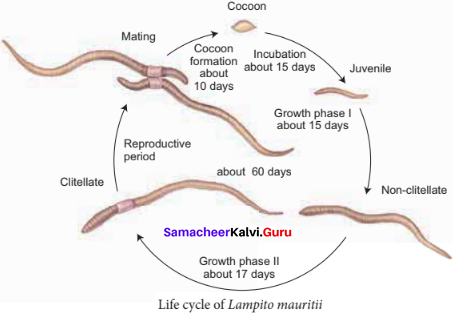
which then develops a clitellum, called the clitellate at the end of the growth phase II taking 15 – 17 days to complete. During the reproductive stage, earthworms copulate, and later shed their cocoons in the soil after about 10 days. The life cycle of Lampito mauritii takes about 60 days to complete.
Question 14.
What are earthworm knowii as friends of farmers?
Answer:
They make burrows in the soil and make it porous which helps in respiration and penetration of developing plant roots. They help in recycling of dead and decayed plant material by feeding on them. Hence they arc called as friends of farmers.
Question 15.
Write a short note on vermitech and
- Vermiculture
- Vermicomposting
- Vermiwash
- Wormery
Answer:
1. Vermiculture :
Artificial rearing or cultivation of earthworms involves new technology for the betterment of human beings. This process is known as vermiculture.
2. Vermicomposting :
The process of producing compost using earthworms is called vermicomposting.
3. Vermiwash :
Vermiwash is a liquid manure or plant tonic obtained from earthworm It is used as a foliar spray and helps to induce plant growth. It is a collection of excretory products and mucus secretion of earthworms along with micronutrients from the soil organic molecules.
4. Wormery or wormbin :
Earthworm can be used for recycling of waste food, leaf, litter and biomass to prepare a good fertilizer in a container known as wormery or wormbin. It makes superior compost than conventional composting methods. Vermiculture, vericomposting, vermiwash and wormery are inter-related and independent process, collectively referred as vermitech.
Question 16.
Explain the morphology of cockroach.
Answer:
The body of cockroach is compressed dorso – ventrally, bilaterally symmetrical and segmented. The body is divisible into head, thorax and abdomen. The entire body is covered by a hard, brown, chitinous exoskeleton. In each segment.
exoskeleton has hardened plates called scierites which are joined by a delicate and elastic articular membrane or arthrodial membrane. The sclerites on the dorsal side are called tergites, and those on the ventral side are called stemites and those on the lateral sides are called pleurites.
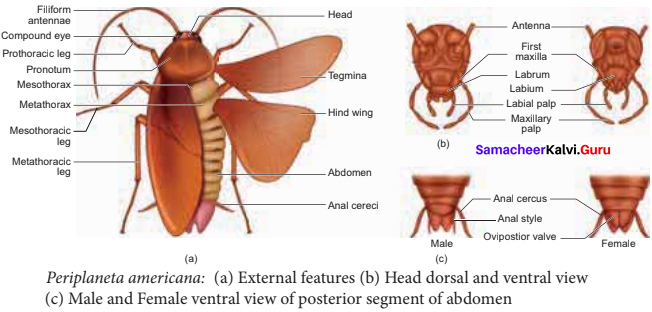
Head :
Head is small, triangular lies at right angle to the longitudinal axis. The mouth parts are directed downwards so it is hypognathous. The head has a pair of large, sessile and reniform compound eyes, a pair of antennae and appendages around the mouth part.
Antennae have sensory organs. The cockroach has a biting and chewing type (mandibulate or orthopterus type) of mouth parts. It includes a labrum, a pair of mandibles, a pair of maxillae, a labium and a hypopharynx or lingua.
Thorax :
The thorax consists of three segments, prothorax, mesothorax and metathorax. The head is connected with thorax by a short neck or cervicum. Each thoracic segment has three pairs of walking legs. Each leg consists of five segments, coxa, trochanter, femur, tibia and tarsus.
The tarsus has five movable joints or podomeres or tarsomeres. A pair of forewings arises from the mesothorax called elytra or tegmina. It protects the hind wings when at rest. The second pair membranous wings arises from the metathorax and are used in flight.
Abdomen :
The abdomen has 10th segments. Each segment has a dorsal tergurn, ventral sternum and between them a narrow membranous pleuron. In female the 7th, segment is boat shaped and together with the gth and 9th sterna forms a brood pouch or genital pouch. Its anterior parts contain female gonopore, spermathecal pores, collaterial glands and the posterior parts constitutes the oothecal chamber in which the cocoons are formed.
in males, the genital pouch lies at the hind end of the abdomen bound dorsally by 9th and 10th terga and ventrally by the 9th sternum. It contains dorsal anus and ventral male genital pore. In both sexes, genital apertures are surrounded by scierites called goriapophysis.
Male has a pair of short and slender anal styles in the 9th stenium which are absent in feniale. In both sexes, the 10th segment has a pair of jointed filanientous structures called anal cerci which is a sense organ that is receptive to vibrations in the air and land. The 7th sternum of male has a pair of large and oval apical lobes orgynovalvular plates which form a keel like structure which distinguishes the male from female.
Question 17.
Explain the digestive system of cockroach.
Answer:
The digestive system of cockroach consists of the alimentary canal and digestive glands. The alimentary canal is present in the body cavity and is divided into three regions: foregut, midgut and hindgut (Figure). The foregut includes pre-oral cavity, mouth, pharynx and oesophagus. This in turn opens into a sac like structure called the crop which is used for storing food.

The crop is followed by the gizzard or proventriculus which has an outer layer of thick circular muscles and thick inner cuticle forming six highly chitinous plates called ‘tecth’. gizzard helps in the grinding of the food particles. The midgut isa short and narrow tube behind the gizzard and is glandular in nature. At the junctional region of the gizzard are eight fingers like tubular blind processes called the hapatic caecae or enteric caecae.
The hindgut is marked by the presence of 100 – 150 yellow coloured thin filamentous maiphigian tubules which arc helpful in removal of the excretory products from the haemolymph. The hindgut is broader than the midgut and is differentiated into ileum. colon, and rectum.
The rectum opens out through the anus. Digestive glands of cockroach consist of the salivary glands. the glandular cells and hcpatic caccac. A pair of salivary glands is found on either side of the crop in the thorax. Thc.glandular cells of the midgut and hepatic or gastric caeeae produce digestive juices.
Question 18.
Explain the circulatory system of cockroach.
Answer:
Periplaneta has an open type of circulatory system (Figure). Blood vessels are poorly developed and opens into the haemocoel in which the blood or haemolymph flows freely. Visceral organs located in the haemocoel are bathed in blood. The haemolynìph is colourless and consists of plasma and haemocytes which are ‘phagocytic’ in nature. Heart is an elongated tube with muscular wall lying mid dorsally beneath the thorax.
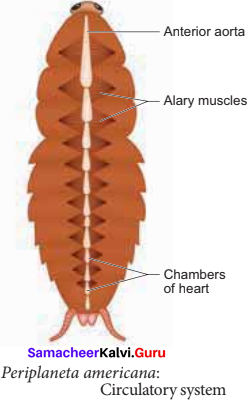
The heart consists of 13 chambers with ostia on either side. The blood from the sinuses enters the heart through the ostia and is pumped anteriorly to sinuses again. The triangular muscles that are responsible for blood circulation in the cockroach are called alary muscles (13 pairs). One pair of these muscles is found in each segment on either side of the heart. In cockroach, there is an accessory pulsatile vesicle at the base of each antenna which also pumps blood.
Question 19.
Explain the nervous system of cockroach.
Answer:
The nervous system of cockroach consists of a nerve ring and a ganglionated double ventral nerve cord. suh-oesophageal ganglion. circum – oesophageaÌ connectives and double ventral nerve cord (see figure). The nerve ring is present around the ocsophagus in the head capsule and is formed by the supra-oesophagial ganglion called the ‘brain’. The brain is mainly a sensory and an endocrine centre and lies above the oesophagus. Sub – oesophageal ganglion is the motor centre that controls the movements of the mouth parts, legs and wings.
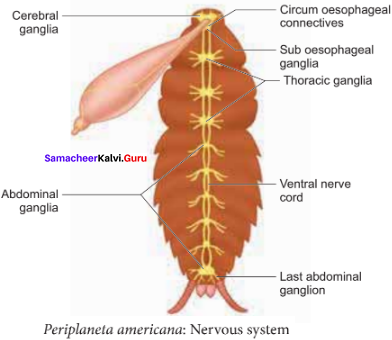
it lies below the oesophagus and formed by the fusion of the paired gangalia of mandibular, maxillary and labial segments of the head. A pair of circum – oesophageal connectives is present around the oesophagus. connecting the supra oesophageal ganglia with the sub-ocsophageal ganglion.
The double ventral nerve cord is solid. ganglionated and arises from the sub-oesophageal ganglion and extends up to the 7th abdominal segment. Three thoracic ganglia are one in each thoracic segment and six abdominal ganglia in the abdomen.
Question 20.
Write about the sense organs of cockroach.
Answer:
In cockroach, the sense organs are antennae, compound eyes, labrum, maxillary alps, labial paips and anal cerci. The receptor for touch (thigmo receptors) is located in the antenna, maxillary palps and cerci. The receptor for smell (olfactory receptors) is found on the antennae. The receptor for taste (gustatory receptors) is found on the paips of maxilla and labium. Thermoreceptors are found on the first four tarsal segments on the legs.
The receptor chordotonal is found on the anal cerci which respond to air or earth borne vibrations. The photoreceptors of the cockroach Consists of a pair of compound eyes at the dorsal surface of the head. Each eye is formed of about 2000 simple eyes called the ommatidia (singular: ommatidium), through which the cockroach can receive several images of an object. This kind of vision is known as mosaic vision with more sensitivity
but less resolution.
Question 21.
Differentiate male and female cockroaches.
Answer:
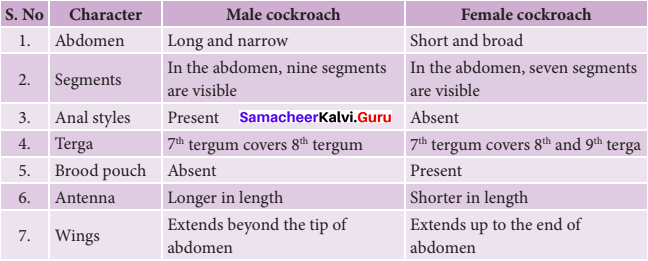
Question 22.
Explain excretion in cockroach.
Answer:
The Malpighian tubules are the main excretory organs of cockroach which help in eliminating the nitrogenous wastes from the body in the form of uric acid. Cockroach excretes uric acid, so it is uricotelic. In addition, fat body, nephrocytes. cuticle, and urecose glands are also excretory in function.
The malpighian tubules are thin, long, tilamentous, yellow coloured structures attached at the junction of midgut and hindgut. These are about 100-150 in number and are present in 6-9 bundles. Each tubule is lined by glandular and ciliated cells and the waste is excreted out through the hindgut.
The glandular cells of the malpighian tubules absorb water. salts, and nitrogenous wastes from the haernolymph and transfer them into the lumen of the tubules. The cells of the tubules reabsorb water and certain inorganic salts. By the contraction of the tubules nitrogenous waste is pushed into the ileum, where more water is reabsorbed. It moves into the rectum and almost solid uric acid is excreted along with the fecal matter.
Question 23.
Explain the male reproductive system of cockroach.
Answer:
Cockroach is dioecious or unisexual. They have well developed reproductive organs. The male reproductive system consists of a pair of testes, vasa deferentia, an ejaculatory duct, utricular gland, phallic gland and the external genitalia. A pair of three lobed testes lies on the lateral side of the 4th and 6th abdominal segments. From each testis anses a thin vas deferens.
which opens into the ejaculatory duct through the seminal vesicles. The ejaculatory duct is an elongated duct which opens out by the male gonopore lying ventral to the anus.
A utricular or mushroom shaped gland is a large accessory reproductive gland, which opens into the anterior part of the ejaculatory duct. The seminal vesicles are present on the ventral surface of the ejaculatory duct, These sacs store the sperms in the form of bundles called spermatophores.
The duct of phallic or conglobate gland also opens near the gonopore, whose function is uncertain. Surrounding the male genital opening are few chitinous and asymmetrical structures called phallomeres or gonapophyses which help in copulation.
Question 24.
ExplaIn the female reproductive system in cockroach.
Answer:
The female reproductive system of cockroach consists of a pair of ovaries, vagina, genital pouch, collaterial glands. spermathecae and the external genitalia. A pair of ovaries lies laterally in the 2nd and 6th abdominal segment. Each ovary is formed of a group of eight ovarian tubules or ovarioles, containing a chain of developing ova. The lateral oviducts of each ovary unite into a broad median common oviduct known as vagina, which opens into the genital chamber.
The vertical opening of the vagina is the female genital pore. A pair of spermathccae is present in the 6th segment, which opens by a median aperture in the dorsal wall of the genital pouch. During copulation, the ova descend to the genital chamber, where they are fertilized by the sperms. A pair of white and branched collaterial glands present behind the ovaries forms a hard egg case called Ootheca around the eggs. Genital pouch is formed by the 7, 8th and 9th abdominal sterna.
The genital pouch has two chambers, a genital chamber into which the vagina opens and an oothecal chamber where oothecae are formed. Three pairs of plate like chitinous structures called gonapophyses are present around the female genital aperture. These gonapophyses guide the ova into the ootheca as ovipositors.
Question 25.
Write a short note on ootheca.
Answer:
A pair of white and branched collaterial glands present behind the ovaries forms a hard egg case called oothcca around the eggs. Ootheca is a dark reddish to blackish brown capsule about 12 mm long which contains nearly 16 fertilized eggs and dropped or glued to a suitable surface, usually in crack or crevice of high relative humidity near a food source. On an average, each female cockroach produces nearly 15 – 40 oothecae in its life span of about one to two years.
Question 26.
Explain the morphological features of frog.
Answer:
The body of a frog is streamlined to help in swimming. It is dorso-ventrally flattened and is divisible into head and trunk. Body is covered by a smooth, slimy skin loosely attached to the body wall. The skin is dark green on the dorsal side and pale ventrally.
The head is almost triangular in shape and has an apex which forms the snout. The mouth is at the anterior end and can open widely. External nostrils are present on the dorsal surface of the snout, one on each side of the median line. Eyes are large and project above the general surface of the body.
They lie behind the external nostrils and are protected by a thin movable lower eyelid, thick immovable upper eyelid and a third transparent eyelid called nictitating membrane. This membrane protects the eye when the frog is tinder water.
A pair of tympanic membranes forms the ear drum behind the eyes on either side. Frogs have no external ears, neck and tail are absent. Trunk bears a pair of fore limbs and a pair of hind limbs. At the posterior end of the dorsal side, between the hind limbs is the cloacal aperature.
This is the common opening for the digestive, excretory and reproductive systems. Fore limbs are short, stumpy, and helps to bear the weight of the body. They are also helpful for the landing of the frog aller leaping. Each forelimb consists of an upper arm.
fore arm and a hand. Hand bears four digits. Hind limbs are large, long and consist of thigh. shank and foot. Foot bears five long webbed toes and one small spot called the sixth toe. These are adaptations for leaping and swimming. When the animal is at rest, the hind limbs are kept folded in the form of letter ‘Z’ Sexual dimorphism is exhibited clearly during the breeding season.
The male frog has a pair of vocal sacs and a copulatory or nuptial pad on the ventral side of the first digit of each forelimb. ‘cal sacs assist in amplifying the croaking sound of frog. Vocal sacs and nuptial pads are absent in the female frogs.
Question 27.
Differentiate between a frog and toad.
Answer:
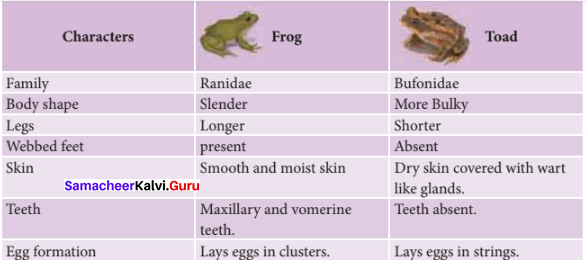
Question 28.
Explain the digestive system of frog.
Answer:
The alimentary canal consists of the buccal cavity, pharynx, oesophagus, duodenum, ileum and the rectum which leads to the cloaca and opens outside by the cloacal aperture. The wide mouth opens into the buccal cavity. On the floor of the buccal cavity lies a large muscular sticky tongue.
The tongue is attached in front and free behind. The free edge is forked. When the frog sights an insect it flicks out its tongue and the insect gets glued to the sticky tongue. The tongue is immediately withdrawn and the mouth closes. A row of small and pointed maxillary teeth is found on the inner region of the upper jaw.
In addition vomerine teeth are also present as two groups, one on each side of the internal nostrils. The lower jaw is devoid of teeth. The mouth opens into the buccal cavity that leads to the oesophagus through the pharynx. Oesophagus is a short tube that opens into the stomach and continues as the intestine, rectum and finally opens outside by the cloaca. Liver secretes bile which is stored in the gall bladder. Pancreas, a digestive gland produces pancreatic juice containing digestive enzymes.
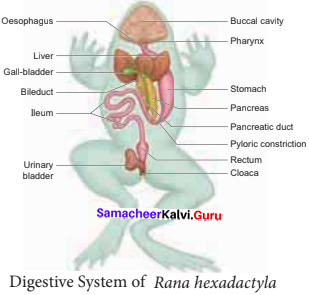
Food is captured by the bilobed tongue. Digestion of food takes place by the action of hydrochloric acid and gastric juices secreted from the walls of the stomach. Partially digested food called chyme is passed from the stomach to the first part of the intestine, the duodenum. The duodenum receives bile from the gall bladder and pancreatic juices from the pancreas through a common bile duct.
Bile emulsifies fat and pancreatic juices digest carbohydrates, proteins and lipids. Final digestion takes place in the intestine. Digested food is absorbed by the numerous finger-like folds in the inner wall of intestine called villi and microvilli. The undigested solid waste moves into the rectum and passes out through the cloaca.
Question 29.
Explain the circulatory system of frog.
Answer:
Blood vascular system consists of a heart with three chambers, blood vessels and blood. Heart is covered by a double- walled membrane called pericardium. There are two thin walled anterior chambers called auricles (Atria) and a single thick walled posterior chamber called ventricle. Sinus venosus is a large, thin walled, triangular chamber, which is present on the dorsal side of the heart. Truncus arteriosus is a thick walled and cylindrical structure which is obliquely placed on the ventral surface of the heart.
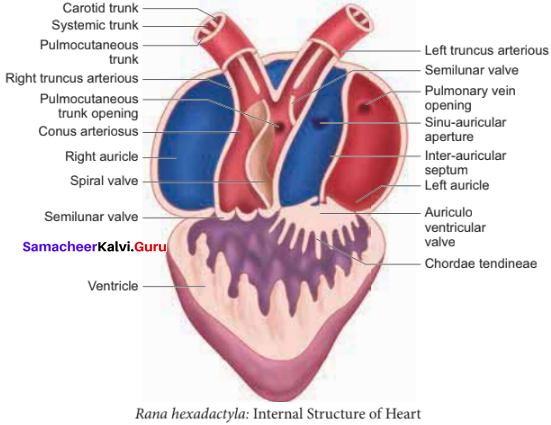
It arises from the ventricle and divides into right and left aortic trunk, which is further divided into three aortic arches namely carotid, systemic and pulmo-cutaneous. The Carotid trunk supplies blood to the anterior region of the body. The systemic trunk of each side is joined posteriorly to form the dorsal aorta. They supply blood to the posterior part of the body. Pulmo-cutaneous trunk supplies blood to the lungs and skin.
Sinus venosus receives the deoxygenated blood from the body parts by two anterior precaval veins and one post caval vein. It delivers the blood to the right auricle; at the same time left auricle receives oxygenated blood through the pulmonary vein. Renal portal and hepatic portal systems are seen in frog.
Question 30.
Explain the nervous system of frog.
Answer:
The Nervous system is divided into the Central Nervous System [CNS], the Peripheral Nervous System [PNS], and the Autonomous Nervous System [ANS], Peripheral Nervous System consists of 10 pairs of cranial nerves and 10 pairs of spinal nerves. Autonomic Nervous System is divided into sympathetic and parasympathetic nervous system. They control involuntary functions of visceral organs.
Question 31.
Explain the structure of brain of frog ?
Answer:
Brain is situated in the cranial cavity and covered by two meninges called piamater and duramater. The brain is divided into forebrain, midbrain and hindbrain. Fore brain (Prosencephalon) is the anterior most and largest part consisting of a pair of olfactory lobes and cerebral hemisphere (as Telen-cephalon) and a diencephalon. Anterior part of the olfactory lobes is narrow and free but is fused posteriorly. The olfactory lobes contain a small cavity called olfactory ventricle.
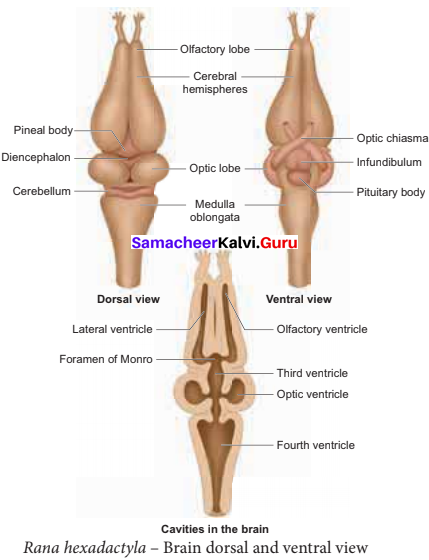
The mid brain (Mesencephalon) includes two large, oval optic lobes and has cavities called optic ventricles. The hind brain (Rhombencephalon) consists of the cerebellum and medulla oblongata. Cerebellum is a narrow, thin transverse band followed by medulla oblongata. The medulla oblongata passes out through the foramen magnum and continues as spinal cord, which is enclosed in the vertebral column.
Question 32.
Explain the excretory system of Frog.
Answer:
Elimination of nitrogenous waste and salt and water balance are performed by a well developed excretory system. It consists of a pair of kidneys, ureters, urinary bladder and cloaca. Kidneys are dark red, long, flat organs situated on either sides of the vertebral column in the body cavity.
Kidneys are Mesonephric. Several nephrons are found in each kidney. They separate nitrogenous waste from the blood and excrete urea, so frogs are called ureotelic organisms. A pair of ureters emerges from the kidneys and opens into the cloaca. A thin walled unpaired urinary bladder is present ventral to the rectum and opens into the cloaca.
Question 33.
Write the short note on the development in frog.
Answer:
Within few days of fertilization, the eggs hatch into tadpoles. A newly hatched tadpole lives off the yolk stored in its body. It gradually grows larger and develops three pairs of gills. The tadpole grows and metamorphosis into an air-breathing carnivorous adult frog (Figure). Legs grow from the body, and the tail and gills disappear. The mouth broadens, developing teeth and jaws, and the lungs become functional.
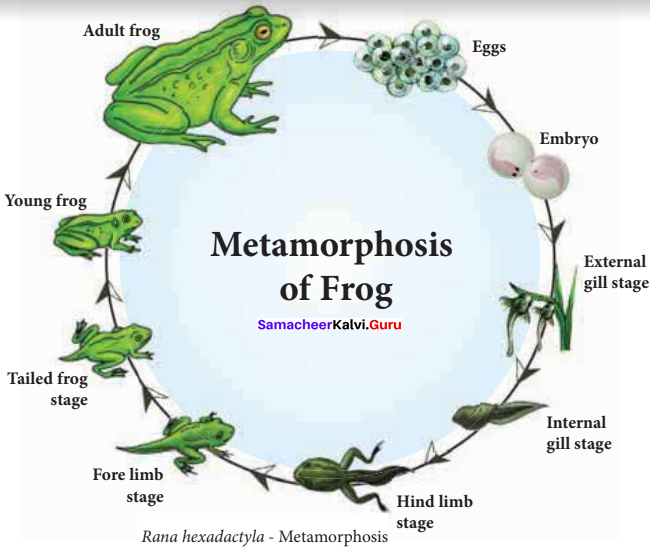
Question 34.
Write a note on the economic importance of frog.
Answer:
Economic importance of Frog:
Frog is an important animal in the food chain; it helps to maintain our ecosystem. So ‘frogs should be protected’.
Frog are beneficial to man, since they feed on insects and helps in reducing insect pest population. Frogs are used in traditional medicine for controlling blood pressure and for its anti aging properties. In USA. Japan, China and North East of India, frogs are consumed as delicious food as they have high nutritive value.
Question 35.
Frog respires through gills, lungs, skin and buccal cavity’. Justify.
Answer:
Frog is amphibious. It respires through lungs (pulmonary respiration) when it is on land. Buccal respiration is there in frog when it is on land. When it is in water, it respires through skin (cutaneous respiration). The larva of frog, tadpole respires through gills. During development, gills disappear and lungs develop and the tadpole metamorphoses into an adult frog. Hence, frog respires through gills, lungs, buccal cavity and skin in its life cycle.
Believing that the Samacheer Kalvi 11th Biology Book Solutions Questions and Answers learning resource will definitely guide you at the time of preparation. For more details about Tamilnadu State 11th Bio Zoology Chapter 4 Organ and Organ Systems in Animals textbook solutions, ask us in the below comments and we’ll revert back to you asap.